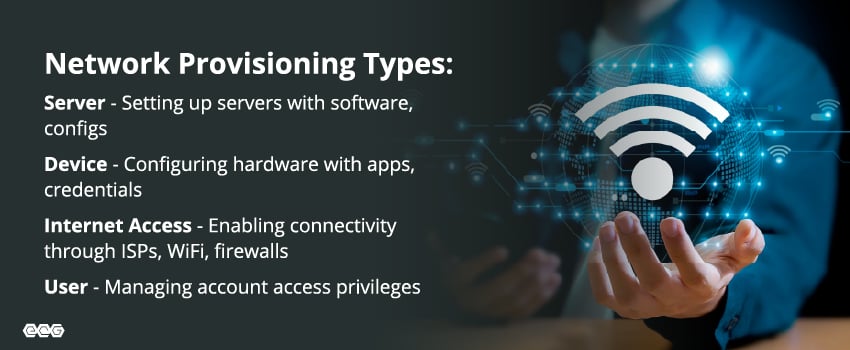What is Network Provisioning?
Network provisioning is a critical process for businesses to ensure authorized users, devices, and servers can access their network. It concerns both connectivity and security, including setting up Wi-Fi users, uploading software, assigning IP addresses, and configuring firewalls. Properly provisioning your network enables your employees to work more efficiently while improving your organization’s cyber security posture.
In this blog, we'll explore the importance of network provisioning for your business and how automated network provisioning solutions can transform your operations.
What Are the Benefits of Network Provisioning?
When done correctly, network provisioning provides enhanced security, as only approved users and devices can access your company’s sensitive systems and data. This reduces the risks associated with digital systems and mitigates potential cyber threats. Other network provisioning benefits include:
Streamlined Workflows
Proper network provisioning can also lead to optimized employee workflows. By ensuring staff have access to the appropriate resources for their role, they can quickly perform duties without obstacles or frustration.
Improved Compliance
Staying compliant with industry regulations around security, accessibility, and more is easier with a well-provisioned network. The controls implemented during provisioning can help your IT team create a digital environment that meets and maintains regulatory compliance requirements.
What Are the Challenges of Network Provisioning?
Manual Provisioning Complexity
Managing network provisioning manually has become increasingly difficult for businesses of all sizes.
Scalability Issues
The rapid growth of devices, remote employees, and network activity makes it challenging to scale without automation.
Time-Consuming Processes
Without automation, provisioning tasks require significant time and effort, slowing down network operations.
Increased Risk of Errors
Manual configuration increases the likelihood of mistakes, which can lead to performance issues and connectivity problems.
.jpg?width=850&height=350&name=ecg_blog_networkprovisioning_inline1%20(1).jpg)
What Is Automated Network Provisioning?
Automated network provisioning uses software to handle many provisioning processes instantly, freeing up network administrators to focus on other tasks and cutting down on human errors that could cause inefficiencies and security issues.
A single IT professional can manage the entire network with automated provisioning tools. The automated software monitors your network as it grows, applies the necessary policies, assigns IP addresses, and configures IP-based devices. Automated tools also provide detailed reports and logs, simplifying network audits and making regulatory compliance easier to achieve.
With automated network provisioning, your IT team can dedicate more resources to innovation and serving customers rather than basic IT support. Plus, automating this once-manual process gives your business a more secure, error-free network primed for growth.
Types of Network Provisioning
When provisioning a business network, a few main areas need configuration for users and systems to function optimally. Traditionally, IT administrators have handled much of this manual setup work. However, modern automated tools can accelerate many provisioning processes.
Server Provisioning
For a network to function, a server must first be provisioned with the right data and software. Manual server provisioning involves installing operating systems, drivers, and enterprise software, setting IPs, configuring virtualization platforms, and auditing the system.
Automated tools simplify many of these tedious IT tasks. Cloud providers often include server provisioning wizards, and automation platforms can self-configure devices based on predefined settings.
Device Provisioning
Before rolling out hardware like computers, tablets, and printers to the workforce, the equipment needs proper configuration and security protocols installed. IT departments have typically handled steps like assigning credentials, apps, and profiles.
Automation instantly sets up these devices, handling enrollment and profile assignments to streamline the process across an enterprise.

Internet-Access Provisioning
Enabling network access for on-site employees and remote staff involves tasks like contracting with ISPs, purchasing networking hardware, configuring wireless access points, installing cabling, and setting up firewalls and security protocols.
Traditionally, network architects handle these duties manually as they build out and update office internet capabilities. Automation can simplify much of this process through solutions ranging from network mapping to AI-powered network configuration.
User Provisioning
Tasks like onboarding new hires, transferring employees, and offboarding those who leave involve provisioning user accounts and access privileges. This often involves coordinating with HR while manually managing identities and permissions, which can be time-intensive.
Automation simplifies user lifecycle management by automatically creating, modifying, or deactivating accounts according to specific triggers, like hiring events. Self-service portals also enable users to request access themselves.
How Network Provisioning Enhances Security
Security is a top priority for businesses managing complex network infrastructures. Automated network provisioning plays a crucial role in maintaining strong security standards, preventing cyber threats, and ensuring compliance with industry regulations.
1. Prevents Unauthorized Access
Automated provisioning enables role-based access controls (RBAC) and strict authentication policies, ensuring that only authorized users and devices can connect to the network.
- Dynamic policy enforcement restricts access based on user roles, locations, or device types.
- Multi-factor authentication (MFA) adds an extra layer of security to prevent unauthorized logins.
2. Reduces Security Misconfigurations
Manual provisioning often results in inconsistent configurations, increasing vulnerability to attacks. Automation, on the other hand:
- Ensures uniform security policies across all network devices.
- Reduces human errors, minimizing the risk of misconfigured firewalls, routers, and switches.
3. Automates Compliance & Audit Readiness
Industries like healthcare, finance, and telecommunications must comply with regulations such as HIPAA, PCI-DSS, and GDPR.
- Automated provisioning enforces regulatory policies in real time.
- Generates audit logs that track access and configuration changes for compliance audits.
4. Enhances Threat Detection & Response
By integrating with AI-driven security analytics, automated provisioning can detect and mitigate threats instantly.
- Real-time monitoring identifies unusual traffic patterns or unauthorized access attempts.
- Automated remediation isolates compromised devices to prevent security breaches.
Automated network provisioning acts as the first line of defense against cyber threats, offering businesses the security and reliability needed to operate in an increasingly digital world.
Industries That Benefit Most from Automated Network Provisioning
The advantages of automated network provisioning extend across various industries that depend on fast, secure, and scalable network deployment. Below are some of the key sectors benefiting from automation.
Telecommunications & ISPs
Automates provisioning for broadband, VoIP, and wireless networks.
Reduces network downtime and improves customer satisfaction.
Enhances multi-tenant support, allowing providers to manage thousands of users efficiently.
Enterprise IT & Cloud Computing
Helps large-scale businesses manage multiple office locations with centralized network control.
Improves IT security and compliance with automated access control.
Supports hybrid and multi-cloud environments, ensuring seamless connectivity.
Healthcare & Medical IT
Ensures secure data transfer and access control for patient records.
Reduces IT overhead by automating network configuration for medical devices.
Helps organizations maintain HIPAA compliance effortlessly.
4Retail & E-commerce
Enables secure point-of-sale (POS) systems across multiple locations.
Reduces downtime by ensuring fast failover provisioning for backup networks.
Enhances network scalability for seasonal demand spikes.
Financial Services & Banking
Protects sensitive financial data with end-to-end encryption and secure network segmentation.
Automates provisioning of remote branches and ATMs to maintain uptime.
Ensures compliance with PCI-DSS and other financial regulations.
Manufacturing & Logistics
Provides real-time IoT connectivity for smart factories and automated supply chains.
Enhances network resilience and redundancy for global operations.
Reduces human intervention, improving overall network efficiency.
By leveraging automated network provisioning, businesses across various industries can reduce operational costs, improve security, and scale efficiently.
How Can Businesses Implement Automated Network Provisioning?
Transitioning to automated network provisioning requires a strategic approach to ensure a seamless, secure, and efficient implementation.
Choose the Right Provisioning Solution
Selecting the right software or platform is the foundation of a successful automated network provisioning strategy. Consider solutions that offer:
- Cloud-based automation for real-time provisioning across locations.
- AI-driven analytics to optimize network performance.
- Integration with existing network infrastructure to avoid disruptions.
Define Clear Network Policies & Access Controls
- Establish predefined security policies to control user access.
- Use role-based provisioning to grant permissions based on job function.
- Implement zero-trust security principles to minimize vulnerabilities.
Integrate with Existing IT & Security Tools
For a smooth transition, automated provisioning tools should integrate with:
- Identity & Access Management (IAM) systems like Okta or Microsoft Entra ID.
- Network Monitoring Solutions to detect and resolve issues automatically.
- Cloud platforms such as AWS, Azure, and Google Cloud for hybrid network management.
Train IT Teams & Conduct Regular Audits
Automation minimizes manual work, but IT teams still need to understand how provisioning policies are applied.
- Conduct staff training to manage automated network processes.
- Perform regular security audits to ensure compliance and detect vulnerabilities.
Monitor, Optimize, and Scale Over Time
- Use real-time analytics to monitor network health and automatically adjust configurations.
- Scale automated provisioning as business needs grow, ensuring future-proof network operations.
- Regularly update automation policies to reflect evolving security threats and compliance changes.
By following these steps, businesses can streamline network operations, enhance security, and scale IT infrastructure efficiently with automated network provisioning.
Speed Up Your Network Provisioning With ECG’s Alpaca
Network provisioning is the backbone of modern business operations, but manually performing this important task takes time and effort that your IT team could use elsewhere. Luckily, automated network provisioning tools like ECG's Alpaca can help streamline your provisioning process and stay ahead of the competition.
Alpaca's bulk provisioning feature lets service providers activate BroadWorks networks in just 30 minutes – not the several hours associated with manual service activation. Alpaca enables you to reuse provisioning templates for faster system rebuilds and pre-validates all imported data to prevent errors, ensuring your network provisioning runs seamlessly.
Ready to learn more about how Alpaca can transform your BroadWorks service delivery? Get in touch with the ECG team today.


